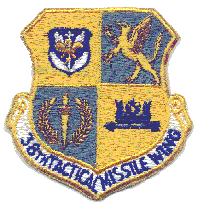|
Sembach Air Base
Hahn Air Base
Bitburg Air Base
Kadena AB
Osan AB
Tainan AB
Lowry AFB
Wheelus AB
Orlando AFB
Camp Happiness
Missile History I
Missile History II
Missile History III
The MM-1
Collectibles
Home Page
Kadena Air Base
Lowry Air Force Base
Orlando Air Force Base
Missile History I
Missile History II
Missile History III
The MM-1
Collectibles
Home Page
|
 |
Hahn Air Base,
Germany |
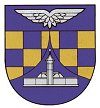
 |
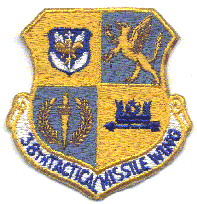
|
|
Matador TM-61A
69th Tactical Missile Squadron
Matador TM-61C
586th Tactical Missile Group |
|
Mace TM-76A (MGM-13A)
89th Tactical Missile Squadron
405th Tactical Missile Squadron
586th Missile Maintenance Squadron |
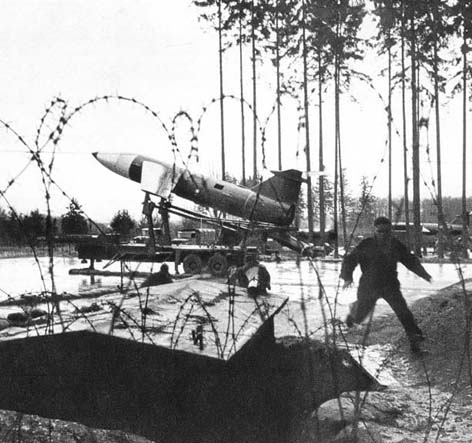
Alert in the real world - The breather door dust plugs are out! |

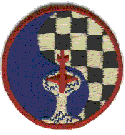
|
The 69th PBS was originally formed on 10 January 1952 at Patrick Air Force Base, Florida, as the second operational missile unit in the United States Air Force. The 69th Pilotless Bomber Squadron (Light), was relieved from Air Force Missile Test Center, AFMTC, (Patrick AFB) on 15 September 1954 after completing training, (Both the 1st PBS and the 69th PBS were assigned to the Tactical Air Command, TAC, on 15 January 1954 and were supported at the Cape and Patrick AFB by the 6555th Guided Missile Group until being relieved from TAC and deployed to USAFE) and was assigned as the first Matador missile unit assigned to Hahn Air Base, arriving at Hahn on September 30, 1954, assigned to the 50th Fighter Bomber Wing. The 69th was attached to the renamed 50th Fighter Day Wing on 14 March 1955. The 69th PBS was assigned to the 7382 Guided Missile Group, which became the 7382 Tactical Missile Group in January 1956.
The 69th PBS was renamed to 69th Tactical Missile Squadron 15 April 1956. The unit manned the TM-61A Matador, which was later replaced by the TM-61C Matador. On 3 August 1956, the 69th Tactical Missile Squadron became part of the 701st Tactical Missile Wing, headquartered at Hahn AB with the deactivation of the 7382nd Tactical Missile Group.
On 18 June 1958, the 69th TMS was inactivated and replaced at Hahn by the 405th Tactical Missile Squadron when the 701st Tactical Missile Wing was inactivated and replaced with the 38th Tactical Missile Wing. The TM-76 A Mace replaced the TM-61C. The 586th Tactical Missile Group was activated at Hahn Air Base as part of the new 38th TMW and became the headquarters for the 405th TMS, the 586th MMS, and the 586th SS.
On 1 September 1959, Sembach became USAFE's primary missile base when the 38th Tactical Missile Wing headquarters moved from Hahn Air Base to Sembach Air Base. The three Tactical Missile Groups assigned as part of the 38th TMW in 1958 continued with their assignments: the 587th TMG at Sembach, the 586th TMG at Hahn AB, and the 585th TMG at Bitburg AB.
The 586th Tactical Missile Group was inactivated 25 Sep 1962, and a new launch squadron, the 89th TMS was created to share duties with the 405th TMS. All missile units of the former 586th TMG at Hahn then reported directly to the 38th TMW at Sembach AB until the 38th TMW was inactivated four years later on 25 September 1966.
All TM-76A, then renumbered to MGM-13A, Mace tactical missile operations at Sembach AB and Hahn AB were inactivated and the remaining 71st Tactical Missile Squadron at Bitburg Air Base was transferred to Bitburg's host 36th Tactical Fighter Wing, which remained on active duty with the CGM-13B (TM-76B) Mace until April 30th, 1969.
|

U.S. Air Force Tactical Missiles
By the Editors of this Website!
|
Beyond the Web Page... The only book devoted exclusively to the Matador and Mace Tactical Missiles. The book reveals the story from the initial idea that became the first U.S. pilotless bomber, through the politically troubled development of the ever evolving deployment methods of the Matador and Mace Tactical Missiles. It covers the Units, Groups, Squadrons and Wing that fielded the missiles. From the United States test sites, Europe, Asia and North Africa nothing is omitted. All phases of the application of these two missiles by the U.S. Air Force (and West German Luftwaffe) are included, from the first tentative launches of the XSSM-A-1 Matador in January 1949, to the tense alert duty of the Cuban Missile Crisis, and the final launch of a MQM13A in May of 1977. The maintenance, logistics and launch, the men, equipment and tactics are all there.
|
|
"Bob, George, I finished your book 2 days after I received it. Couldn't put it down. It was incredible reading and incredibly detailed information."
Kent Washburn (KWASH55@aol.com) Mace B, Kadena, Okinawa
"George and Bob. I want you both to know how much I enjoyed reading and how much I admire and appreciate what you have accomplished in developing and publishing "The Pioneers". It is truly an outstanding piece of work, reflecting the time and effort required to produce it, but is also a formidable contribution to our military history. I mentioned in some earlier correspondence that I was a little disappointed in the relatively small amount of information regarding the Operating Location/Guidance Sites but you largely made up for it with this magnificent book."
Dale Lake (daleflake@yahoo.com) 601st Tactical Control Squadron, 38th TMW, Hamm, Germany
"I just finished your book, The Pioneers, et al. Please accept my "job well done!" Not only is it informative, but it's very readable. I'd also like to complement you on how well you footnoted it. You have shown that a scholarly work can be both instructive and enjoyable."
Michael Roof (lavinaschnur@hotmail.com) SGM USA (Ret.)
|
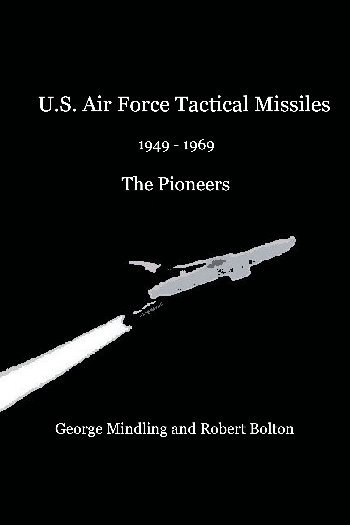
ISBN 978-0-557-00029-6
"Very good work with great detail."
Col. Charlie Simpson, USAF, Retired
Executive Director
Association of Air Force Missileers
"George, the book arrived on Tuesday while I was off to France. Of course, I quickly read the chapter about Germany's quiet step into the realm of nuclear armament. You know, this is still a widely ignored fact over here...
...For me it is fascinating to see what the picture really was in the 1950s and 1960s as opposed to what the official communication of the time wanted people to believe. A fascinating book shedding some light on the early days of tactical nuclear missiles as well as the political background that even today is still largely hidden behind the propaganda of the time. Can't wait to read the rest of it."
Burkhard Domke
Harsefeld, Germany
"U.S. Tactical Missiles 1949-1969 The Pioneers"
|
"I have your excellent book on USAF tactical missiles. I actually witnessed the decommissioning of the Maces at Wüscheim back in 1966."
Paul Offen
Talitha, Tye Common Road
Billericay
Essex CM12 9PX
UK
"I just wanted to drop you a line and tell you how much I enjoyed the book that you and Bob wrote. The history was of particluar interest to me and my brother who was a history Professor at the University of Wisconsin. He also thought the book was well written, and he now knows what his little brother, (me), did while in Germany for three years."
George Joseph Snyder (gjsnyder@lanset.com)
71st TMS, Steinborn, Germany
"...by the way, I read your book, it was great, thanks for writing it."
Hack Hunton (hack@sstelco.com) Mace B, Kadena, Okinawa
|
|
US Air Force Tactical Missiles
2008 - George Mindling and Robert Bolton |
|
Inspired by the 38th TMW Website, George Mindling and Robert Bolton co-authored US Air Force Tactical Missiles 1949 - 1969: The Pioneers 2008, the story of America's first operational missiles, from the Matador to the Mace, from Taiwan, Korea, and Okinawa to Germany, including Lowry, Orlando, Holloman, Santa Rosa Island at Eglin, and even Camp Happiness!
|
|
Dieses Buch ist ein Muss für alle, die im Rahmen ihres Dienstes bei der U.S. Air Force mit den frühen Marschflugkörpern
zu tun hatten, aber auch für deutsche Militärarchäologen, die in der Eifel, im Hunsrück oder im Pfälzer Wald schon
über rätselhafte Hinterlassenschaften gestolpert sind. Nach mehr als 40 Jahren wird endlich eine Fälle von Fakten,
Informationen und Geschichten zu den zwischen 1954 und 1969 in Deutschland stationierten, mit Automwaffen ausgerüsteten
amerikanischen Matador und Mace auf den Tisch gelegt.
Ausfährlich und lebendig erzählen George Mindling und Bob Bolton von den jungen Missilemen, die im März 1954 erstmals in Bitburg ankamen -
noch ganz grün im Gesicht, weil auf dem Atlantik schwerer Sturm geherrscht hatte. Von den T-33-Flugzeugen, die aus übungsgründen so taten, als
wären sie Matador-Flugkörper, äber die Startstellungen hinweg in Richtung deutsch-deutsche Grenze donnerten und sich von der Gegenseite
nur nicht erwischen lassen durften. Oder von der Kuba-Krise, als die US Air Force Europe auf DEFCON 3 ging und an die Mechaniker in
Bitburg Munition für ihre Karabiner ausgegeben wurde.
Augenzeugen sagen dazu: "Wir hätten die Vögel auf jeden Fall innerhalb von 15 Minuten in der Luft
haben müssen!" Es ist lebendige Militärgeschichte, die nun nicht der Vergessenheit anheimfällt, sondern
jedermann zugänglich wird - auch für die ortsansässige Bevökerung, die heute endlich erführt, was sich damals
in ihrer Nachbarschaft zugetragen hat. Den beiden Autoren gebührt der Dank.
Klaus Stark (klaus_stark@t-online.de)
Berlin, Germany
This book is not only a must for all those who served in the U.S. Air Force with the early cruise missiles, but also for German military archeologists who have been puzzling over relics stumbled across in the Eifel, the Hunsrück and the Palatinate Forests. After more than 40 years, we finally have a wealth of facts, information and stories, from 1954 to 1969, of the nuclear equipped American Matador and Mace missiles stationed in Germany placed on the table.
With detailed and vivid descriptions, George Mindling and Bob Bolton talk about the young Missilemen who arrived for the first time in March, 1954, in Bitburg - still green in the face, having prevailed the Atlantic crossing in major storm. Of the T-33 aircraft which practiced as if they Matador missiles launched in the direction of German-German border, or from the Cuban missile crisis, when the U.S. Air Force Europe went on DEFCON 3 and was issued ammunition to the mechanics in Bitburg for their rifles. Eyewitnesses say: "We would have to have the birds in the air in any event within 15 minutes!"
It is vital military history that is prey to oblivion, but is now accessible to everyone - even for the local population, which today finally learns what happened at that time in their neighborhood.
The two authors deserve thanks for saving the history.
Klaus Stark,
klaus_stark@t-online.de
Berlin, Germany
|
|

|
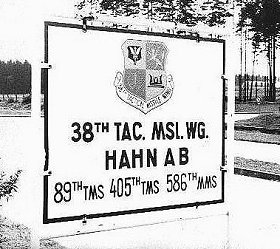
Photo Courtesy of the Mace & Matador Tactical Missile Association
|
|
"I had no idea that a TM-61C
was still in Germany! If they only knew how important it was to their security
and peace of mind back in the late '50s and '60s, they would gold plate it and erect it at
Templehoff in Berlin. There were often weeks of ice and glazed runways at Hahn, and Bitburg
when no F-100 could get out of its shelter -- zero braking action and steerability. During
those times we held down the entire SIOP -- every target worth a darn in
East Germany and Central Europe."
Brig. Gen. Fred W. Vetter USAF (ret)
Former Commander of the 585th Tactical Missile Group
The Monument was originally dedicated Bitburg Air Base by then Col. Fred W. Vetter,
September, 1962
|
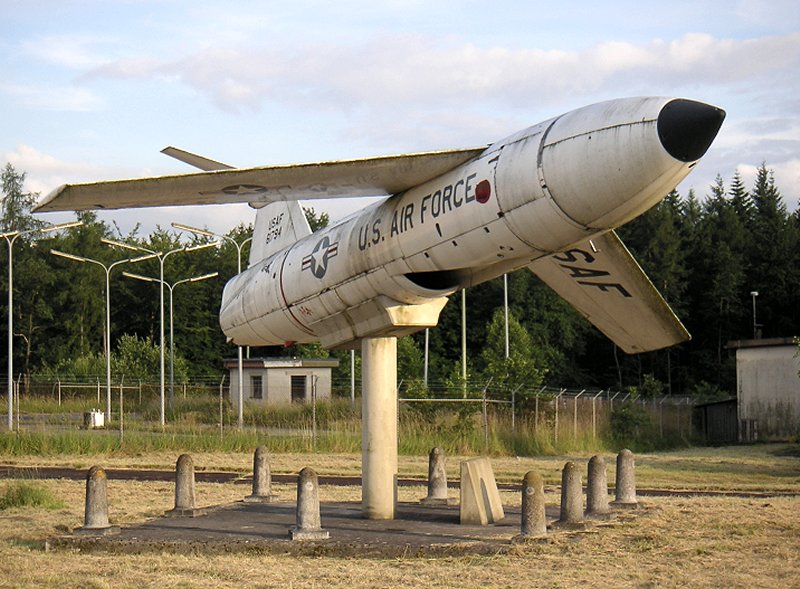 |
|
The above photo courtesy of David Behre (Davidbehre@aol.com)
|

|
This Missile Monument was originally dedicated in the
Missile Support Area, Oberweis, at Bitburg Air Base in September, 1962, the month the last
operational Matador was taken out of service. A story about the original dedication and the
photo from the Overseas Weekly can be found at the Bitburg MSA page
The story of the Matador's salvage and rebuild after years of neglect and the story of it's move from MSA to Wüscheim is on S/Sgt Max Quitiquit's page about saving the TM-61C Missile Monument.
Obviously, It will have to be saved a second time if it is to survive as a
monument to the first U.S. missile crews in Europe. |

"I was the last man from the US Army there (MSA at Bitburg) when we closed it down and turned it over to Air Force again. The Missile Monument was taken down in Nov 88 and shipped to Wüscheim in Jan 1989. We used to have to clean it. When they came and asked about taking it; I told that was no problem with us. It was a cool thing there though. I have many good and bad memories of MSA. I was there from 1984 till I close it out in Nov 1991.
Thanks again, Rick
PS: The missile is still in Wüscheim on the German Army Training site now also for the Rave Party every year.
Richard Zais (richard.zaiz@us.army.mil)
|

Metro Tango Training Site
Matador Photos Courtesy of Dave Johnston, SMSGT USAF (Ret) (fordman1@pa.net)

What's in a name? Check the page at
Metro Tango for a brief narrative of site history |


|
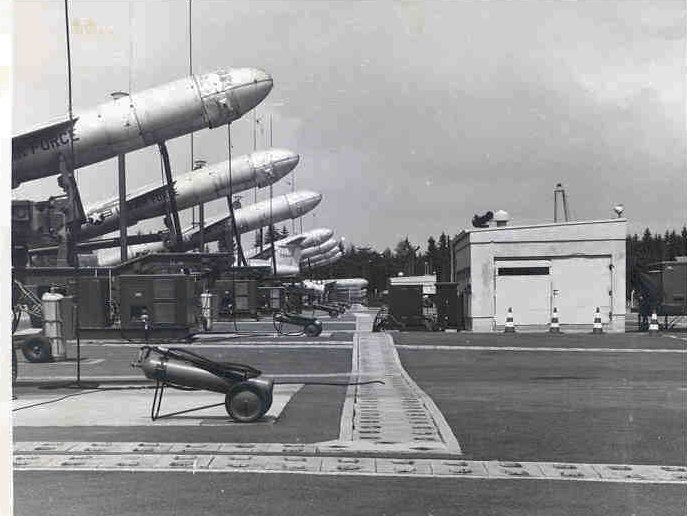
TM-76A (MGM-13A) Mace of the 405th Tactical Missile Squadron on alert - 1963
|


Site IV - 2002 |
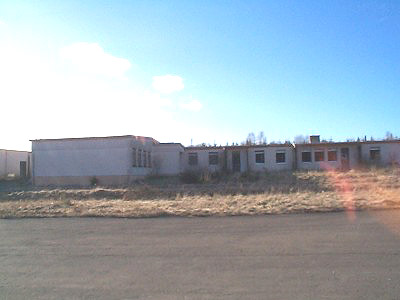 |
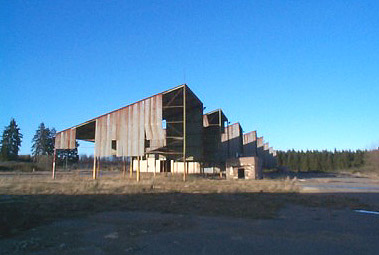 |
Hello,
My name is Tobias Geiss and I live near Site IV. I found your page on the internet and thought you might enjoy some pics I shot of the area in 2002. You can put them on your homepage if you like.
Best regards,
Tobias Geiss (vladdes@freenet.de)
Editor's Note: Many thanks to Tobias Geiss for the recent photos of Site IV. We welcome all photos from the old launch and maintenance sites.
|

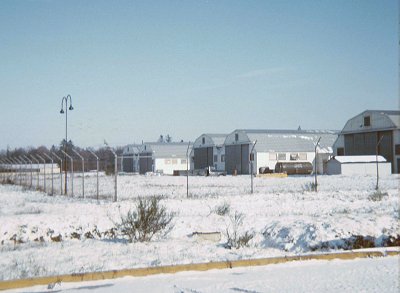
The 586th Missile Maintenance Squadron
on-base maintenance area at Hahn Air Base.
The area was located near the "back gate", referred to as the "Koblenz" Gate.
|

MM-1 Transporters parked outside
the maintenance hangars at Hahn. |
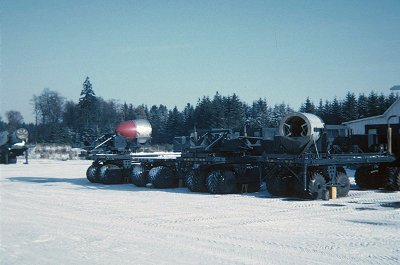
|
An "A" Bird nose section sits on a transporter,
while an empty warhead section waits nearby.
For the benefit of those stationed at Hahn,
the bright light is from the Sun! |
586th MMS Photos courtesy of Dave Maas
(DrMaas@aol.com)

A Prophetic Note From A TAC Missileer...
Hello Gang;
I will be off line for the next 5 weeks, I will be back after the 10th of November.
My past has placed me into the position to be nominated as a UN Weapons Inspector.
I was contacted in July by the US State
Department that my past credentials placed me as a candidate as a United Nations Missile expert.
I leave for Vienna Austria day
after tomorrow for a 5 week basic training course. After that I'll be assigned to a UN Weapons
Inspection Team. I guess you can
take the missileer out of missiles, but you can't take missiles out of the missileer?
It's both an honor and a curse, wish me luck.
Dave Maas (DrMaas@aol.com)
Everyone at the TAC Missileers
Association wishes Dave the best of luck on this timely and important mission.
|

Memories of Hahn Air Base
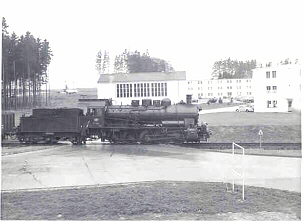
The Train and the Chapel
(Notice the Deuce
in the background)
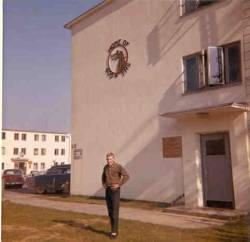
405TMS Barracks, Hahn Air Base, Germany |
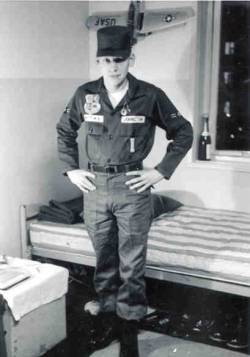
A2C Johnston models the
Uniform of the Day, 38TMW, Hahn AB, Germany
|
People always pointed at
your chest and asked,"what's that?"
At first, you'd proudly
say "That's my missile badge!"
Then they would say,
"No, those things in the plastic container on your lapel!"

Missileers know! |
|
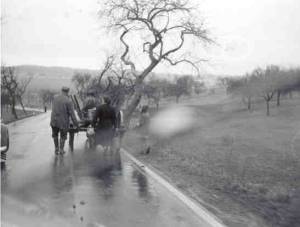
Terracruzer's Nightmare! |
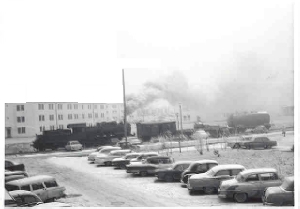
The Train in Winter |

Flood in front of the base hospital
|
Hahn Air Base Photos Courtesy of Dave Johnston, SMSGT USAF (Ret) (fordman1@pa.net)

|
"Good Morning, as it is here in the UK as I write this.
I came on your great site
by chance, whilst researching missiles. I'm writing because I met a lot of
guys from Hontheim(or Hundheim) missile base during my service in the
British Army. We were in the Cochem area on exercise, and met some of your
guys. They took us back to the base, and we were treated like the proverbial
royalty! Great guys, one and all, and if any read this, God bless you all,
guys! Names that spring to mind are Gary Sansom, and Charles Varnardo.(I've
still got his cap, wonder if you've got my beret, Charlie)
All the very
best to you all, on that side of "The Pond", and thanks for that great
hospitality."
Best Regards, Gary (j.jones61@ntlworld.com). |

"The Ferry May Not Be Here!" warning
sign at Cochem |





This page is in no way sponsored or endorsed by the United States Air Force.
Opinions and views expressed are those of the author and not necessarily those of the
Department of the Air Force.
|
Web Page Design and Development by
George Mindling - Port Charlotte, Florida
© George Mindling - 2003-2006 All Rights Reserved
|
|
|
